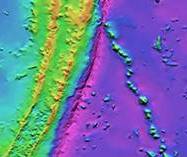 The dolphins are gone.
The dolphins are gone.
I know where the dolphins are because of the sensor: hundreds of miles away near one of the major ocean trenches, Tonga-Kermadee (see sat topography pic).
That’s way beyond the range of the boat, or any other vessel around here for probably 300 nautical miles in any direction.
Me and Kiki went out in the boat yesterday when they were closer to see if the tracking might be off but it was a waste of time. The kit is working all too well, just not telling me a good story.
He says there have always been dolphins here. That it’s my fault that the dolphins have left and that I’ve brought bad spirits here.
With due respect to the man’s beliefs, its nonsense of course, but disconcerting nonsense. When i put this to him, he walked away. We haven’t spoken since.
This is bad. The protocol of my study demands that I check in on the dolphins and keep track on them visually. I don’t have to do this often, but I do have to do it, I have to check that the sensor is in a pod. And I can’t do it without Kiki.
They might be back soon. There is still a great deal we do not know about these animals.
They may have found some new feeding grounds. Dolphin and whale pods and other large ocean-dwelling predators near the top of the food chain tend to aggregate around ocean trenches, ridges, and regions where there is a large rise or fall in the sea floor. It’s all to do with the way that the ocean cycles and recycles nutrients so that the primary producers, like algae, can support a viable enough population of small predators, like small fish, which in turn supports a population of larger predators, and so on.
I don’t really know much about the Tonga-Kermadee trench. Large tracts of the ocean are like deserts really: all the nutrients sink to the sea floor, the benthic zone, and so there’s very little happening in the open sea, the pelagic.
I don’t think this is likely but it is possible that the baby is on it’s own, lost, abandoned by the pod. The sensor may have made it a target. They are aggressive creatures dolphins, and juveniles are no exception.
If it is alone it won’t last long. It won’t know how to hunt yet. Dolphins pods hunt cooperatively, even with other pods for large shoals of fish, which they coerce into tight formations sometimes called bait balls where the fish suffocate from exertion from the chase and the lack of oxygen in the tight, densely packed shoal.
On its own its finished. With the mother, there’s a chance.
The stress is getting to me and the headaches are back. When they get worse, so do the dreams.
I live, eat and breathe dolphins and I dream about them all the time, once few times a year. It’s not that unusual. But last night, I was actually attacked by another dolphin for the very first time. It hurt. I felt pain. The force of the attack… was incredible.
I was sick as I woke and the headache has never left. My hut stinks.